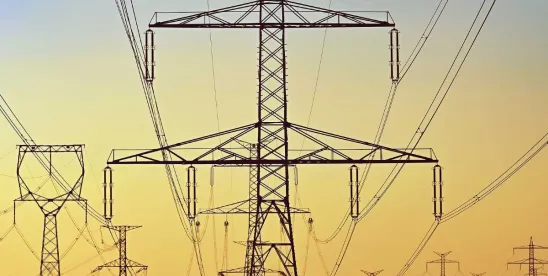Regional electric grid operators—already facing resource adequacy and reliability challenges with baseload capacity retirements and changes in the generation resource mix—are now grappling with unprecedented increases in near-term electric power demand driven by data centers and new industrial loads. PJM Interconnection, L.L.C. (PJM), Midcontinent Independent System Operator, Inc. (MISO), and Southwest Power Pool, Inc. (SPP) each are attempting to address near-term resource adequacy concerns by expediting interconnection studies for high-priority generation projects.
PJM’s Reliability Resource Initiative (RRI)
PJM was the first among the grid operators to propose an expedited interconnection study process, filing its RRI proposal with the Federal Energy Regulatory Commission (FERC) on 13 December 2024. RRI is a one-time expansion of the eligibility criteria for Transition Cycle #2 in PJM’s existing interconnection queue.1 PJM would evaluate potential RRI projects using market impact and commercial operation date viability criteria,2 with PJM selecting up to 50 projects that would best satisfy the need for reliable capacity that could come online quickly.3
In a 3-1 “close-call” decision issued on 11 February 2025, FERC accepted the proposal, finding that RRI reasonably addressed the possibility of a resource adequacy shortfall driven by significant load growth, premature retirements, and delayed new entry.4
PJM opened RRI’s one-time application window in late February 2025. Of the 94 applications submitted,5 PJM selected 51 projects, which together will provide more than 9,300 MW of incremental capacity to the region.6 Now under study in PJM’s Transition Cycle #2 study process,7 these projects are expected to sign interconnection agreements by January 2027.8
FERC’s order approving PJM’s RRI proposal provided insight into how Commissioners might vote on other grid operators’ expedited interconnection proposals. In the order, Commissioner Rosner noted, if RRI were not a one-time emergency request, he would not find PJM’s proposal to be just and reasonable and he would have had fewer reservations about PJM’s RRI proposal if the commercial operation date viability criteria were stronger.9 In Commissioner Chang’s dissent, she stated she is interested in potential solutions to address looming reliability challenges, but expressed concern that PJM’s proposal compromises FERC’s open access principles with no guarantee that it will actually resolve PJM’s impending capacity shortage.10
Six rehearing requests filed by environmental organizations and others alleged that FERC’s order is arbitrary and capricious and fails the standard for approval under the Federal Power Act. Rehearing parties argue that the RRI proposal is inadequately supported, is a violation of the filed rate doctrine and rule against retroactive ratemaking, violates open access principles, will be ineffectual, and will be harmful to legacy Transition Cycle #2 projects, among other contentions. FERC is expected to issue a rehearing order in the coming months.11
MISO’s Expedited Resource Addition Study (ERAS)
MISO filed its expedited interconnection study process, ERAS, shortly after FERC issued its order approving PJM’s RRI proposal. ERAS differs from RRI in several ways. Unlike RRI, ERAS does not cap the number of projects eligible to participate in the study process. Also, unlike PJM’s process, MISO itself would not select the projects for inclusion in ERAS; instead, projects would be selected by Relevant Electric Retail Regulatory Authorities (RERRAs).12 Further, MISO’s ERAS process would run separately from the general interconnection process and would study projects serially; by contrast, PJM’s RRI integrates with the general interconnection queue and studies projects in the cluster. Additionally, unlike PJM’s one-time window, MISO’s ERAS would accept applications on a quarterly basis until the first of either 31 December 2028 or the completion date of the 2027 study cycle for MISO’s general interconnection queue.13
On 16 May 2025, FERC rejected MISO’s ERAS proposal in a 2-1 decision.14 While the majority agreed that ensuring reliability and resource adequacy is of critical importance, two aspects of MISO’s proposal proved fatal.15 First, although MISO expected to study only tens of ERAS interconnection requests each year, MISO put no limit on the number of participating projects, which could result in an ERAS queue with processing times too lengthy to meet MISO’s reliability needs.16 Second, MISO had not demonstrated that its proposal would actually solve identified reliability needs. Given the unlimited number of interconnection requests that could participate in the ERAS, the ERAS would not ensure the interconnection of critical resources on an expedited basis and resolve resource adequacy needs.17
FERC rejected MISO’s ERAS proposal without prejudice, which means that MISO may refile a modified proposal that addresses the concerns discussed in the order.18 MISO intends to file its revised proposal on 6 June 2025. Opposition is likely.
SPP’s Expedited Resource Adequacy Study (ERAS)
SPP filed its expedited interconnection process, ERAS, on 22 May 2025.19 SPP’s ERAS is a one-time process like PJM’s RRI; however, like MISO’s proposal, SPP’s ERAS would be conducted separately from the regular generator interconnection study process.20 While SPP’s ERAS proposal does not limit the number and type of candidate projects, the resource adequacy deficit of each specific Load Responsible Entity (LRE), as calculated by SPP, would operate to effectively set a capacity ceiling and limit the number of projects that can enter ERAS.21 LREs would select eligible projects, attest to the need for the selected resource’s output, and commit the new resource toward the LRE’s resource adequacy obligations and new transmission service.22 SPP’s ERAS projects would be required to reach commercial operation within five years of the ERAS application window’s closing.23
Like PJM’s RRI and MISO’s ERAS proposals, this proposal is expected to be met with mixed reviews from intervenors. Comments on SPP’s ERAS proposal are due 12 June 2025.
Outlook
The electric regulatory landscape is rapidly changing. A complex confluence of changes in supply and demand is driving proposals for expedited interconnection of high-priority generation and storage projects. On the supply side, grid operators are faced with a shortage of generation capacity due to a variety of factors, such as accelerated retirements of baseload generation, backlogged interconnection queues, and supply chain constraints as well as constraints related to skilled workers. On the demand side, grid operators are expecting substantial increases in load growth from data centers and industrial manufacturing.
Resource adequacy and artificial-intelligence-driven data center development is now a major legal and policy issue appearing in practically all branches and levels of government. On the first day of his presidency, President Donald J. Trump issued Executive Order No. 14156, declaring a national energy emergency and asserting the use of executive emergency powers to address these challenges. On 8 April 2025, the President issued Executive Order No. 14262, finding that the United States is experiencing an “unprecedented surge in electricity demand driven by rapid technological advancements” and directing the Secretary of Energy to expedite the Department of Energy’s (DOE’s) processes for taking emergency action under section 202(c) of the Federal Power Act. In May, DOE issued emergency orders directing MISO and PJM to maintain the operational availability of generation facilities scheduled for shutdown.24 FERC’s approval of expedited interconnection studies for high-priority capacity projects should assist to address near-term resource adequacy concerns in PJM, MISO, and SPP.
Ready To Help
The firm's Power practice group is closely monitoring these developments and stand ready to assist clients navigating the evolving laws, regulations, and policies surrounding generator interconnection, resource adequacy, and grid reliability.
Footnotes
1 PJM Interconnection, L.L.C., Tariff Revisions for Reliability Resource Initiative, Docket No. ER25-712-000 (filed Dec. 13, 2024).
2 Id. at 30-33. PJM scores RRI projects using (1) market impact criteria, assigning up to 65 points based on unforced capacity, effective load-carrying capability, and location; and (2) commercial operation date viability criteria, assigning up to 35 points based on planned in-service date, project support, uprates, and headroom.
3 Id. at 3, 27.
4 PJM Interconnection, L.L.C., 190 FERC ¶ 61,084, at P 1 (2025) (RRI Order).
5 Reliability Resource Initiative Draws 94 Applications, PJM Inside Lines (Mar. 21, 2025), https://insidelines.pjm.com/reliability-resource-initiative-draws-94-applications/; PJM Interconnection Process Subcommittee, RRI Status Update (published Apr. 22, 2025), https://www.pjm.com/-/media/DotCom/committees-groups/subcommittees/ips/2025/20250424/20250424-item-04---reliability-resource-initiative-status-update.pdf.
6 PJM Chooses 51 Generation Resource Projects to Address Near-Term Electricity Demand Growth, PJM Inside Lines (May 2, 2025), https://insidelines.pjm.com/pjm-chooses-51-generation-resource-projects-to-address-near-term-electricity-demand-growth/ (“The projects consist of 39 uprates and 12 new construction proposals. The uprates apply to existing natural gas, nuclear, coal and onshore wind resources. Of the new projects, half are gas, five are batteries and one is nuclear.”).
7 Reliability Resource Initiative Draws 94 Applications, PJM Inside Lines (Mar. 21, 2025), https://insidelines.pjm.com/reliability-resource-initiative-draws-94-applications/.
8 PJM Interconnection Process Subcommittee, Transition Progress Update (published May 23, 2025), https://www.pjm.com/-/media/DotCom/committees-groups/subcommittees/ips/2025/20250528/20250528-item-03---tc1-tc2-update.pdf.
9 RRI Order, Cmm’rs Rosner and Phillips Concurrence at PP 7, 12. The commercial operation date viability criteria assesses whether the capacity can be constructed and in commercial operation in the near term, i.e., 2028-2031.
10 RRI Order, Cmm’r Chang Dissent at PP 2, 6.
11 PJM Interconnection, L.L.C., Notice of Denial of Rehearing by Operation of Law and Providing for Further Consideration (issued Apr. 14, 2025).
12 A RERRA is “[a]n entity that has jurisdiction over and establishes prices and/or policies for providers of retail electric service to end customers, such as the city council for a municipal utility, the governing board of a cooperative utility, the state public utility commission or any other such entity.” MISO Electric Tariff, Module A (common tariff provisions).
13 Midcontinent Indep. Sys. Operator, Inc., Expedited Resource Addition Study Filing, Docket No. ER25-1674-000, at 24 (filed Mar. 17, 2025).
14Midcontinent Indep. Sys. Operator, Inc., 191 FERC ¶ 61,131 (2025). Commissioners Rosner and See issued concurring opinions, with Chairman Christie dissenting.
15 Id. at PP 199-202.
16 Id. at P 199.
17Id.
18 Id. at PP 1, 25.
19 Southwest Power Pool, Inc., Tariff Revisions to Implement the Expedited Resource Adequacy Study, Docket No. ER25-2296-000 (filed May 22, 2025).
20 Id. at 25.
21 Id. at 29-30.
22 Id. at 30.
23 Id. at 43-44; id. at Proposed Attachment AW, Section 1 (Definitions), “Expedited Resource Adequacy Study Window (ERAS Window).”
24 DOE’s Use of Federal Power Act Emergency Authority, DOE (last visited June 4, 2025), https://www.energy.gov/ceser/does-use-federal-power-act-emergency-authority.




 />i
/>i

